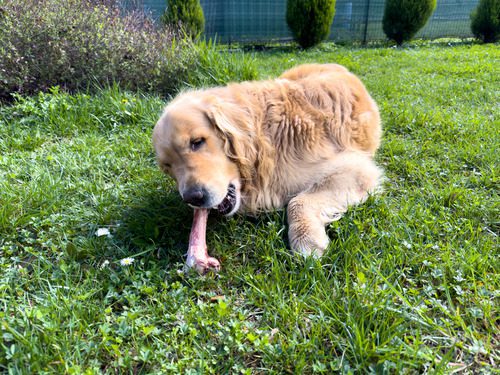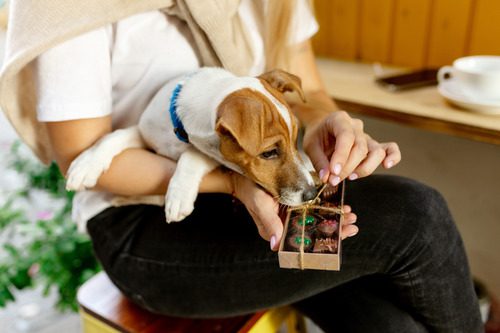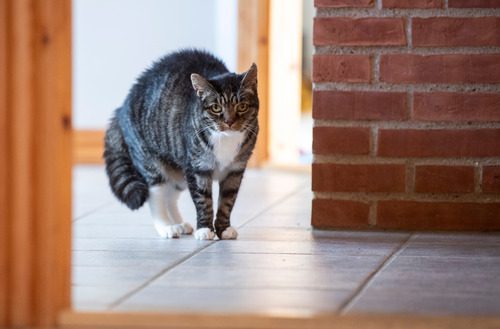Dog Body Language: What is Your Dog Trying to Tell You?
Have you ever wondered what your dog is trying to communicate to you? Do you wish you knew more about dog body language? Many dog owners find themselves stumped by their dogs’ behavior and messages, and if you feel the same way, you’re not alone.

5 Ways Dogs Communicate Through Dog Body Language
In the article below, we’ll walk you through the basics you need to know about your dog’s body language. When you’ve finished reading, you should be able to better recognize your dog’s communication style and determine what they want you to know at any given time. Let’s get started!
Below are the different ways dog body language is used to help them communicate:
1. Posture
Posture is one of the many ways a dog can communicate how they are feeling easily.
Upright and Loose
For example, if your dog is standing upright with a loose pose, this means they are happy, content, or excited.
Hunch Near the Ground
If they hunch close to the ground, on the other hand, they are scared or stressed and want to get away from the situation.
“Bowing”
A dog who “bows” with the front of the body low to the ground and the rear end and haunches up in the air is feeling playful. When showing this behavior, your dog wants you or another household pet to play with them.
2. Dog Facial Expressions
Dogs use their facial expressions to show their mood, but the meaning of these expressions isn’t always the same as it is in humans.
Lip Licking and Yawning
Many canine facial expressions can indicate fear, including lip licking and frequent yawning. Yawning can also sometimes indicate nausea or illness in a dog.
Showing Their Teeth
A dog who is snarling with the upper lip curled back and teeth baring is aggressive, but a dog who is showing their teeth while otherwise exhibiting calm body language is trying to prove they aren’t there to hurt you. It can take some time to learn canine facial expressions.
3. Tail Wagging in Dogs
Your dog’s tail is by far the most expressive part of their body, and learning how to recognize how the tail plays a role in dog body language can help you understand your pet more thoroughly. Many dog owners mistakenly believe that tail wagging in dogs is always a positive expression, but in reality, it can be negative too.
Long and Slow
If your dog’s tail wags are long and slow, this means they are relaxed and happy. These are the type of tail wags you may see in a dog who is very familiar with the situation or person involved—such as when you get home after you’ve been out all day.
It is believed that dogs wag their tails toward the right when they are happy about something familiar, although some dogs may spin the tail in a circle instead!
Fast and Twitchy
Dogs who have a twitching or very fast-wagging tail, or a tail that is wagging more to the left, may be anxious or scared. They may also be on high alert and could turn aggressive, depending on the dog and the situation.
A dog who is feeling aggressive or assertive will hold their tail high up over their body, while a calm dog will keep the tail neutral (relative to the breed’s natural tail position).
4. Dog Hackles
The hackles of a dog refer to the ridge of hair down the center of the dog’s back. Just like humans can feel the hair on the back of their neck stand up, dogs can experience this too. However, it is much more visible in most dogs, and can mean many things.
Raised
If your dog’s hackles are raised, they may be feeling aggressive. But they could also be feeling excited, stressed out, or sexually interested in another dog. It’s important to look at other dog body language indicators your pet is showing at the same time to determine why their hackles are raised.
5. Eyes
Your dog’s eyes may look relaxed or tense, and these variations are not unlike the same changes found in a human’s expression.
Relaxed
If your dog’s eyelids are relaxed, they are likely calm, sleepy, or comfortable.
Wide with Fixed Stare
On the other hand, if their eyes are wide and their stare is fixed, they are nervous or aggressive.
Not Showing Eye Contact
Dogs look away from eye contact when they want to show they aren’t a threat. This is one reason why it can be difficult to train your dog to make eye contact with you, although most dogs will eventually get the hang of this with enough treats.
Contact Our Team for More Information on Dog Body Language
It can take some time and practice to get the hang of understanding your dog’s body language. Don’t worry if you don’t get it right the first time, but also don’t be afraid to keep trying. Your dog is sure to be patient with you while you try to understand what they want you to know.
Overall, through body language, your dog will tell you how they’re feeling. Whether they’re nervous, happy, stressed, or angry, there will be indicators that will help tell you what’s going on with them.
If you have any further questions about your dog’s body language, you can ask your veterinarian for more information. You may also want to reach out to a professional and skilled dog trainer, who is likely to be well-versed in dog behavior and body language, too. Book an appointment for your dog at any of our Heart + Paw locations. Our team will help guide you on what dog body language means and how you can help your pet.
Recent Posts
Can Dogs Eat Ham?
Ham is a popular meat found on many dinner tables, especially during the holidays. As a dog…
8 Signs and Symptoms of Diabetes in Dogs
Caring for a dog means being tuned in to the subtle changes that can reveal their overall…
Why Dogs Can’t Eat Chocolate and Tips for Keeping This Sweet Treat Out of Their Reach
Chocolate is a beloved indulgence for us, but for our dogs, it’s a hidden danger that can…
Why Cat Teeth Cleaning is Important For Your Pet’s Health
As a cat owner, you know how important it is to care for your feline friend’s overall…
Cat Body Language: A Guide To Understand What Your Cat is Telling You
Imagine trying to communicate without words, relying solely on subtle gestures, glances, and movements. This is how…
About Us
Heart + Paw was founded in 2018 by Chief Veterinary Officer Dr. George Melillo, who currently serves the Mid-Atlantic area. Heart + Paw offers a combination of veterinary care, pet grooming, and dog daycare to help be a resource in your pet parenthood journey.
We'd Love to Meet Your Four-Legged Friends
Find out how the friendly veterinary team at your local Heart + Paw can help your pets live longer, healthier lives by searching for a location near you.





